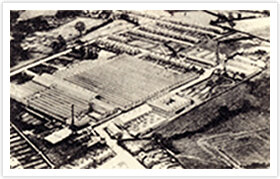Part 3
Part 3: The first steps to becoming a modern manufacturer
In launching Japanese production of automatic telephone exchanges, OKI, which since its founding had sought to develop and produce its products entirely in Japan, would enter into a technological partnership with a firm from Great Britain, where use of such exchanges had advanced considerably. In doing so, the company set a new course, moving away from its earlier existence as a collection of skilled craftspeople to establish a modern production system.
Two steps toward the future

Based on the government's second and third telephone expansion plans, the installation of telephone lines in Japan advanced steadily throughout the Meiji and Taisho eras. In 1923, while this progress was underway, the Great Kanto Earthquake struck the entire Kanto region, including Tokyo. In response to the earthquake, OKI worked as hard as it could to restore the telephone network. Day after day, OKI employees gave their all to produce exchanges and telephones, working without rest to restore the system and to make emergency repairs to system components and materials.
The Great Kanto Earthquake presented two courses of action for the future of Japan's telegraph and telephone systems. One resulted in the start of radio broadcasting, a step that had been repeatedly planned, in response to the fragility of landline communications in the event of a disaster. The other was the introduction of automatic exchanges that were more earthquake-resistant and could be restored more easily in the event of unforeseen circumstances. While this technology had been invented much earlier, in 1887, it had reached the stage of practical application only a few years earlier, even in Europe and North America, due in part to the massive funding already invested in the market for manual exchanges.
On January 20, 1926, Japan's first automatic telephone exchange began operating at the Kyobashi telephone office. While this marked a historic milestone in the Japanese telephone business, the inner thoughts of the OKI organization on the matter were more complex. This was because all automatic exchange equipment was ordered from overseas manufacturers. OKI, too, which had worked very hard to restore telephone equipment, needed to look toward domestic production and the in-house development of automatic exchange equipment to prepare for the future.
Underlying all this was the harsh experience of the shift from magnetic to common-battery exchanges. The main components were dominated by imported parts produced by Western Electric. While OKI had tried to shift to domestic production of these parts, it had proved most difficult to produce the complex components. It also faced patent barriers. Ten years went by since the first import of Western Electric exchanges before OKI's own common-battery exchanges passed testing by the Ministry of Communications and Transportation and were introduced to market.
OKI's decision to partner with General Electric of Great Britain

OKI naturally believed the technological standards set by this automatic exchange equipment would create even more difficulties than the common-battery system. In response, OKI sent adviser Kakichi Uchida, a former vice-minister of Communications and Transportation, on a tour of Europe, concluding an agency agreement with Britain's General Electric Company. However, the true purpose was to learn about their technologies and begin domestic production of automatic exchanges. OKI quickly concluded an agreement on a technological partnership, then immediately sent engineers to the Peel-Conner Telephone Works, where GEC's telephone exchanges were produced.
Meanwhile, in Japan, construction had begun on the Shibaura Plant. With the completion of the first phase of the construction project, the Provisional Automatic Exchange Start-Up Department began operating. Staff members with experience at the Peel-Conner Telephone Works played a central role here, along with two British engineers as their technological mentors, Gamble and Alderman. To OKI, which had advocated full domestic production since its founding, employment of engineers from overseas truly marked a revolutionary step.
Focusing efforts on the domestic production of automatic exchanges

Following the appointment of Gamble and Alderman, a succession of products arrived from Great Britain, including automatic exchanges produced by GEC at Peel-Conner, switch parts, tools, gauges, material samples, and machine tools. A new culture was introduced to the company. Production advanced in accordance with systematic process controls under the guidance of these two engineers from overseas, based on the same tools and quality control using standardized gauges.
This was a major shock to the employees who had worked at the plant. At the time, the "union contract system," a system whose purpose was to improve productivity and skills and under which craftspeople and other workers formed individual teams in each field under a union head, remained a major factor at OKI's plants. One can easily imagine the consternation of the union heads, in whom the craftsperson's temperament was particularly strong, when faced with this new production system.
At the same time, three members of personnel with experience at the Peel-Conner Telephone Works, sensing a clear need for production controls and quality controls, discussed reforms in old work practices at the new Shibaura Plant. These individuals understood that skilled craftspeople, who had learned largely through traditional long-year apprenticeships, could not come to grips with the complex and elaborate manufacture of automatic exchanges in a short time.
Based on these reforms, at the end of 1928, OKI succeeded in producing the assemblies and parts used in automatic exchanges in-house. The need for automatic exchanges had put OKI on the path toward its status as a modern manufacturer.
